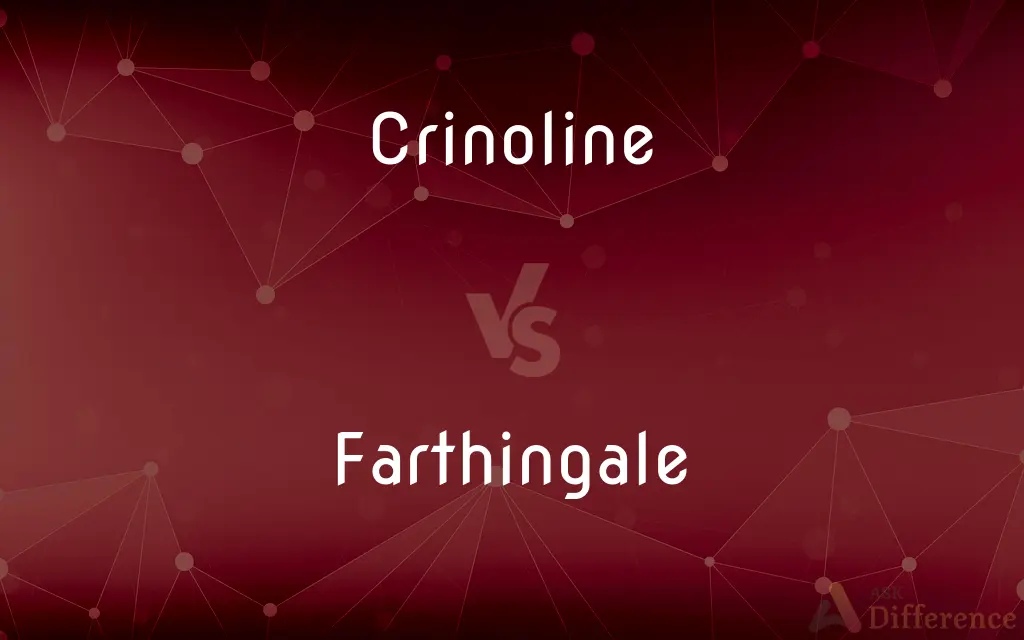Crinoline vs. Farthingale — What's the Difference?
By Tayyaba Rehman & Maham Liaqat — Updated on April 23, 2024
Crinoline, a stiff fabric or framework used to expand women's skirts, gained popularity in the 19th century; farthingale, a hoop skirt predecessor from the 16th century, utilized hoops to shape skirts distinctly.

Difference Between Crinoline and Farthingale
Table of Contents
ADVERTISEMENT
Key Differences
Crinoline, developed primarily in the 19th century, utilized materials like steel, horsehair, or thread mesh to create voluminous skirt shapes. In contrast, the farthingale, which originated in the 16th century in Spain, was typically made from whalebone or willow, creating a conical shape to support the skirts.
While crinolines were designed to create a smooth, bell-shaped silhouette popular during the Victorian era, farthingales aimed to structure the skirt into a rigid, extended horizontal shape, particularly noticeable in the Tudor court.
Crinolines often involved a cage-like structure that could be collapsed for convenience, whereas farthingales were generally fixed in their circumference and less flexible, making them more cumbersome to wear.
The use of crinoline became a broader cultural symbol of fashion and social status in Victorian society, whereas the farthingale was more specifically a courtly garment, signifying nobility and often restricted to formal occasions.
Both garments, however, played crucial roles in defining women’s fashion during their respective periods, emphasizing the shifting ideals of female beauty and the evolving technology of garment construction.
ADVERTISEMENT
Comparison Chart
Time Period
19th century
16th century
Material Used
Steel, horsehair, or thread mesh
Whalebone or willow
Shape
Bell-shaped
Conical and horizontal
Structure
Collapsible cage structure
Fixed circumference, less flexible
Cultural Significance
Symbol of Victorian fashion and broader social status
Courtly garment, symbol of nobility and formality
Compare with Definitions
Crinoline
A cage-like framework worn under skirts in the Victorian era.
Her crinoline creaked softly with each step she took.
Farthingale
Constructed typically from whalebone or willow branches.
The rigid structure of her farthingale was unmistakably crafted from whalebone.
Crinoline
Pertaining to the fashion of wearing voluminous skirts.
The crinoline era was marked by extravagant silhouettes and elaborate dress parties.
Farthingale
Symbolic of high social standing and formality in dress.
At court, a farthingale was as much a necessity as a crown.
Crinoline
A stiffened or structured petticoat designed to hold out a woman's skirt.
The crinoline made her skirt billow out dramatically as she twirled.
Farthingale
Originated in 16th century Spain and popular in Tudor England.
The portrait depicted her in a farthingale, marking her as a woman of status.
Crinoline
Used figuratively to describe voluminous or expansive styles.
The decorator preferred crinoline-like drapes for the grand hall.
Farthingale
Used to create a distinctive silhouette that influenced European fashion.
The farthingale set the trend for wide, imposing skirts that dominated the era.
Crinoline
Also refers to the stiff fabric used to make such garments.
The dress's volume was achieved with layers of crinoline.
Farthingale
A hoop skirt or a frame worn under skirts to expand them at the hip line.
Her farthingale kept everyone at a polite distance in the crowded room.
Crinoline
A crinoline is a stiff or structured petticoat designed to hold out a woman's skirt, popular at various times since the mid-19th century. Originally, crinoline was described as a stiff fabric made of horsehair ("crin") and cotton or linen which was used to make underskirts and as a dress lining.
Farthingale
A farthingale is one of several structures used under Western European women's clothing in the 16th and 17th centuries to support the skirts in the desired shape and enlarge the lower half of the body. It originated in Spain in the fifteenth century.
Crinoline
A coarse stiff fabric, originally of cotton and horsehair, used especially to line and stiffen hats and garments.
Farthingale
A support, such as a hoop, worn beneath a skirt to extend it horizontally from the waist, used by European women in the 1500s and 1600s.
Crinoline
A petticoat made of this fabric.
Farthingale
(historical) A hooped structure in cloth worn to extend the skirt of women's dresses; a hooped petticoat.
Crinoline
A hoop skirt.
Farthingale
A hoop skirt or hoop petticoat, or other light, elastic material, used to extend the petticoat.
We'll revel it as bravely as the best, . . . With ruffs and cuffs, and farthingales and things.
Crinoline
A stiff fabric made from cotton and horsehair.
Farthingale
A hoop worn beneath a skirt to extend it horizontally; worn by European women in the 16th and 17th centuries
Crinoline
A stiff petticoat made from this fabric.
Crinoline
A skirt stiffened with hoops.
Crinoline
Any of the hoops making up the framework used to support cladding over a boiler.
Crinoline
Netting placed around ships to guard against torpedoes.
Crinoline
A kind of stiff cloth, used chiefly by women, for underskirts, to expand the gown worn over it; - so called because originally made of hair.
Crinoline
A lady's skirt made of any stiff material; latterly, a hoop skirt.
Crinoline
A skirt stiffened with hoops
Crinoline
Full stiff petticoat made of crinoline
Crinoline
A stiff coarse fabric used to stiffen hats or clothing
Common Curiosities
What is a crinoline made of?
Crinoline is made from materials such as steel, horsehair, or thread mesh to create a structured yet flexible skirt shape.
What cultural significance did the farthingale hold in historical fashion?
The farthingale was a symbol of nobility and formality, mostly worn at court and during official ceremonies.
When was the farthingale popular?
The farthingale was popular during the 16th century, particularly in Spain and Tudor England.
Can a crinoline be collapsed for easier movement or storage?
Yes, crinolines were designed with a collapsible cage-like structure for more practical wear and storage.
How did wearing a farthingale impact a woman’s mobility?
The fixed and wide structure of the farthingale made it cumbersome, limiting mobility significantly.
What impact did crinolines have on Victorian society?
Crinolines were a cultural icon in Victorian society, symbolizing both fashion evolution and the era's distinct social hierarchy.
Why were farthingales primarily a courtly garment?
Due to their extravagant design and cumbersome nature, farthingales were suited for the formal and ceremonial settings of the court.
How does the shape of a crinoline differ from a farthingale?
A crinoline creates a bell-shaped skirt, while a farthingale shapes skirts into a rigid, horizontal cone.
What were the primary functions of crinolines and farthingales?
Both garments aimed to shape women's skirts, though the crinoline offered a more practical and adjustable approach compared to the farthingale.
How did the introduction of crinolines influence women’s fashion in other aspects?
The introduction of crinolines led to wider skirts and more elaborate dress designs, impacting other fashion elements like bodices and sleeve styles.
Was the crinoline ever used in everyday fashion?
Yes, during the Victorian era, crinolines were commonly worn by women daily, reflecting broader societal norms and fashion trends.
Did men ever wear crinolines or farthingales?
No, both garments were exclusively part of women's fashion to shape and support skirts.
How did fashion transition from farthingales to crinolines?
Fashion evolved from the rigid and structured farthingale to the more practical and flexible crinoline as materials and fashion preferences changed.
How did the materials used in crinolines and farthingales compare?
Crinolines used newer, more flexible materials like steel, whereas farthingales were made from traditional materials like whalebone or willow.
Are crinolines still used today?
Crinolines are not commonly used in everyday fashion but are seen in historical reenactments and some formal attire.
Share Your Discovery

Previous Comparison
Logo vs. Emblem
Next Comparison
Emplore vs. ImploreAuthor Spotlight
Written by
Tayyaba RehmanTayyaba Rehman is a distinguished writer, currently serving as a primary contributor to askdifference.com. As a researcher in semantics and etymology, Tayyaba's passion for the complexity of languages and their distinctions has found a perfect home on the platform. Tayyaba delves into the intricacies of language, distinguishing between commonly confused words and phrases, thereby providing clarity for readers worldwide.
Co-written by
Maham Liaqat














































